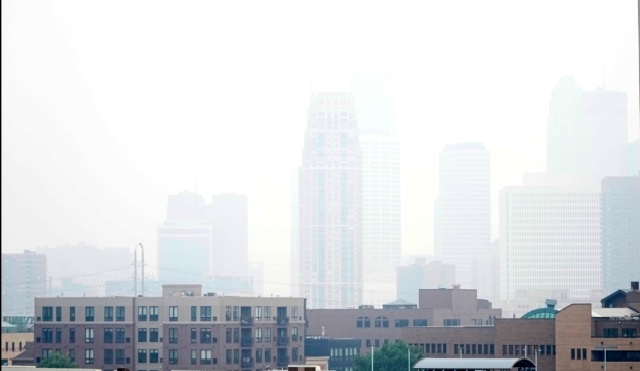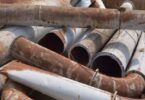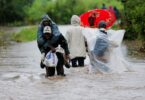Zack Budryk
Parts of the U.S. are likely to see a resurgence of the wildfire smoke that blanketed the East Coast last week, with New York projected to see further haze Friday and parts of the upper Midwest already having major issues with air quality.
New York is not expected to see a full resurgence of the sepia-toned cloud of smoke that rendered it barely visible last week, as the National Weather Service says it’s likely to remain far above the ground. Meteorologists say a smoky smell may be noticeable as well.
Minneapolis, however, saw air quality levels on Thursday morning deemed “very unhealthy” by air quality company Plume Labs.
As of Friday morning, levels in the city have returned to “excellent” levels. Around the same time, Chicago saw an Air Quality Index of 137, which is unhealthy for some vulnerable populations, and eastern Iowa issued an air quality alert effective through 10:00 Friday night.
Experts say the recurring danger is partially due to both the intensity and the early onset of Canada’s wildfire season.
“Overall we’ve seen a historic wildfire season in Canada right now,” said Vijay Limaye, a climate and health scientist in the Natural Resources Defense Council’s Science Office. “We’re talking about 13 million acres burned at this point, which is far above the average we would expect to see at this point in June.”
There are now 446 fires burning across Canada, including two that started Friday. Just under half of the fires are classified as “out of control,” according to the Canadian Interagency Forest Fire Center.
The nation’s national fire preparedness level sits at 5, indicating the country has committed all available national resources against the blaze. The plurality of active fires—127 of them—are located in Quebec, the source of last week’s smoke.
As to the rapid shifts back and forth in air quality south of the border, Limaye said, “we’re sort of at the mercy of the winds—the fires continue to burn and I wouldn’t be surprised if we see intense smoke exposures return to the East Coast over the summer.”
Future episodes of wildfire smoke reaching the U.S. may not all be as visually dramatic as last week’s clouds, but “in terms of these fine particles and the other air pollutants involved in wildfire smoke, there’s really no safe exposure level,” he noted.
FireSmoke Canada, which maps forecasted smoke coverage across the U.S.-Canada border, indicated as of Friday morning that smoke from Canadian fires was detectable over a broad swath of the U.S. at certain times on Friday, affecting states including Kentucky, Ohio, Michigan and Indiana.
“Some of the fires are dying down, smoke’s clearing, [but] there are still going to be increased particles in the air that are residual,” said Alif El-Hasan, a spokesperson and physician volunteer for the American Lung Association. “Wildfire areas, even when the fire is gone, still have a lot of soot, a lot of ash and other chemicals that are lingering and … can still cause issues.”
Going forward, he added, “it would be really important for people to still monitor government websites, air quality websites to see what the air quality is outside.”
El-Hasan noted that people with respiratory conditions like asthma in particular should remain vigilant and consider wearing high-quality masks outdoors if those sources indicate a higher risk.
“Even if you think it’s clearing, people could still be in danger, it could still hurt people’s health and they need to be mindful of it,” he said.
While last week was many on the East Coast’s first experience with air pollution from fires on this level, it should function as “a bit of a wake-up call” for the region, Limaye said.
“In terms of the distribution of wildfire smoke-related health impacts, a lot of the smoke tends to come from the western U.S., but a study from 2021 indicates about a third occurs outside of the west,” he said, citing the far greater population density on the other side of the country.
“This is something now becoming an international public health crisis,” he said. “All the science is pointing toward intensifying health hazards.”
Courtesy: thehill







